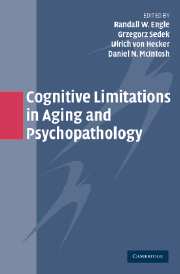Book contents
- Frontmatter
- Contents
- List of Contributors
- Preface
- Acknowledgments
- 1 Cognitive Limitations in Aging and Psychopathology: An Introduction and a Brief Tutorial to Research Methods
- SECTION I WORKING MEMORY AND COGNITIVE FUNCTIONS
- SECTION II AGING AND PSYCHOPATHOLOGY OF COGNITIVE CONTROL
- SECTION III ATTENTION, INHIBITION, AND REASONING PROCESSES
- 10 The Nature of Attentional Bias in Human Anxiety
- 11 Inhibition, Rumination, and Mood Regulation in Depression
- 12 Aging and Inhibitory Processes in Memory, Attentional, and Motor Tasks
- 13 Impairments of Memory and Reasoning in Patients with Neuropsychiatric Illness: Disruptions of Dynamic Cognitive Binding?
- 14 Generative Reasoning as Influenced by Depression, Aging, Stereotype Threat, and Prejudice
- Name Index
- Subject Index
- References
13 - Impairments of Memory and Reasoning in Patients with Neuropsychiatric Illness: Disruptions of Dynamic Cognitive Binding?
Published online by Cambridge University Press: 20 May 2010
- Frontmatter
- Contents
- List of Contributors
- Preface
- Acknowledgments
- 1 Cognitive Limitations in Aging and Psychopathology: An Introduction and a Brief Tutorial to Research Methods
- SECTION I WORKING MEMORY AND COGNITIVE FUNCTIONS
- SECTION II AGING AND PSYCHOPATHOLOGY OF COGNITIVE CONTROL
- SECTION III ATTENTION, INHIBITION, AND REASONING PROCESSES
- 10 The Nature of Attentional Bias in Human Anxiety
- 11 Inhibition, Rumination, and Mood Regulation in Depression
- 12 Aging and Inhibitory Processes in Memory, Attentional, and Motor Tasks
- 13 Impairments of Memory and Reasoning in Patients with Neuropsychiatric Illness: Disruptions of Dynamic Cognitive Binding?
- 14 Generative Reasoning as Influenced by Depression, Aging, Stereotype Threat, and Prejudice
- Name Index
- Subject Index
- References
Summary
INTRODUCTION: REPRESENTATION AND PROCESS IN HIGHER LEVEL COGNITION
Decrements in higher level cognitive abilities are a prevalent feature of dementia associated with psychiatric illnesses, such as schizophrenia and major depression; degenerative neurological disorders, such as Alzheimer's disease and Parkinson's disease; and the normal aging process. The kinds of cognitive deficits that are typically associated with these conditions are fairly well characterized through the wealth of neuropsychological studies dealing with each. However, the task of establishing the link between particular forms of pathophysiology associated with each condition and specific cognitive impairments has proved more difficult. A satisfactory resolution of this issue depends, to a large extent, on the ability to describe what individuals can and cannot do cognitively – what kinds of percepts and concepts they can and cannot represent. I will argue that psychological studies of reasoning have attempted to characterize information processing limitations in two ways: (a) by describing the nature and complexity of percepts and concepts manipulated in reasoning, and (b) by specifying their reliance on working memory, which involves the ability to temporarily store and manipulate pieces of information.
The former approach, I contend, has been used to show that differences in reasoning abilities across cognitive developmental stages or phylogeny, as well as reasoning impairments resulting from brain damage in humans, might be explained by the presence or absence of the ability to represent knowledge structures of a given complexity.
- Type
- Chapter
- Information
- Cognitive Limitations in Aging and Psychopathology , pp. 346 - 376Publisher: Cambridge University PressPrint publication year: 2005



